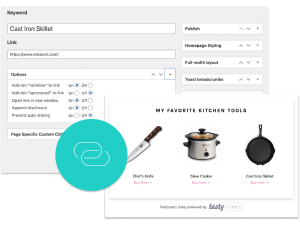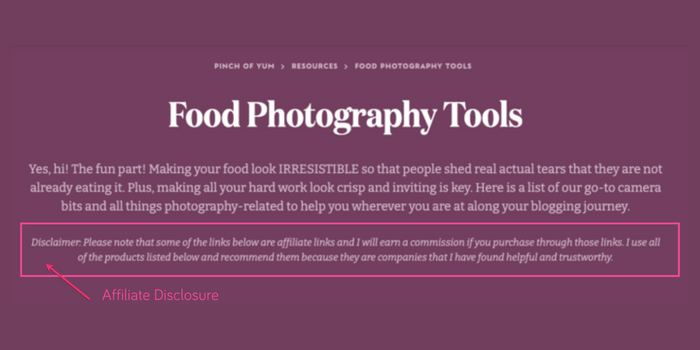You need to know how to promote affiliate links AND how not to promote them.
You’ve seen it before, right? Affiliate links so random they make you pause. Someone pushing teeth whiteners one day and blue light glasses for dogs the next. Definitely not the best way to do it. 😜
But in all fairness, it's easy to get tangled up in how many links to use and where to put them.
In this guide, you'll get the best (and worst) ways to promote your affiliate links in 2025. I’ll also share where to place them and how to make them work harder for you.
Let’s turn your links into clicks and commission — without the cringe.
- Where to promote your affiliate links
- Best ways to promote your affiliate links (5 Best Practices)
- How NOT to promote affiliate links ❌
- Use Tasty Links to promote your affiliate links smarter, not harder
Where to promote your affiliate links
1. Your blog or website (Your home base 🏡)
This is especially true if your website is the main hub you're driving traffic to!
Your targeted audience is coming there for YOUR trusted info, thoughts, and recommendations. That's why it's a great place to share affiliate links to your favorite products or services.
Here are a few places on your site to promote affiliate links. 👇
Blog posts & product reviews
Have content about a must-have kitchen gadget, your go-to travel gear, or a beauty product that changed your routine?
These are perfect spots for relevant affiliate links!
If you're a food blogger, try putting affiliate links in your recipes. Add your affiliate links to your favorite blender or olive oil you use regularly. That way, it's easy for readers to know what you use and grab exactly what they need.

And with a WordPress link plugin like Tasty Links, you don’t have to add them manually.
Just add the links once and create keywords. Then, it automatically links those keywords to your affiliate products. Or, you can turn them into clickable images with the Featured Link Block.
Product roundups
Product roundups are a great way to share your favorite finds while helping your readers choose the best products. Plus, people love a good themed list!
Check out Kristin Espinar from Must See Spain. 🇪🇸
She put together a product roundup post of Essential Safety Items for Solo Female Travelers. She uses affiliate links in her text and Featured Link Blocks (with Tasty Links!) to show each promoted product in a helpful and easy-to-shop way.

Resource pages
A resource page puts all your must-have products in one easy-to-find spot.
You can create a simple list of links or make it prettier with clickable product images. We do this at WP Tasty too!
Here's our Favorite Kitchen Gadgets page for an example. And, of course, we used the Featured Link Block to do it.👇

Tasty Links makes it easy add affiliate links to WordPress AND update them. One quick change, and every page on your site stays up to date.
It’s an easy way to keep your resources and product recommendations organized while boosting your affiliate sales on autopilot. 🎉
2. Social Media (Where your audience hangs out 📲)
You don’t need to be on every social media platform. Start with where your audience already is.
Instagram & TikTok
These social platforms are all about short, engaging videos.
So, show your favorite product in action and make it part of your content, not just a random plug.
Say you’re a travel creator on a trip. Film a quick video of your favorite backpack in action and mention why you love it. Then, add an affiliate link in your bio, caption, or link sticker so viewers can check it out.

When people see stuff in use, it feels more like a genuine recommendation than a sales pitch.
If you want to promote affiliate links on Pinterest, you’ve got two easy options:
1️⃣ Link directly to an affiliate product – Quick and simple, but make sure your affiliate program and Pinterest allow it.
2️⃣ Pin to a blog post with affiliate links – The best long-term strategy! Create a Pin that grabs attention and links back to a helpful post where your links are naturally included.
There are also Pinterest ads. But for now, let's stick to more ideal ways for beginners to promote affiliate links.
Facebook is a popular social media site to promote affiliate links, but how you do it matters.
You can post them on your business page, in your own Facebook group, or in niche communities (just check the rules first — some don’t allow affiliate links).
One easy way? Share a helpful post that links to content with your affiliate links.
Sustainably Kind Living does this in the example. Instead of dropping an affiliate link outright, she shared a blog post full of useful recommendations.

And while Facebook ads are another option, they’re a paid strategy (and a whole other topic for another day). 😉
For now, you're getting the rundown on how to promote affiliate links for free.
3. Email campaigns and newsletters (Your most loyal followers 💌)
Your email list is full of people who are there for a reason. They want to stay in the know about your product, brand, or maybe just you! And, they trust you.
Don't forget, keep it natural and helpful.
Take The Marketing Millennials newsletter as an example. Instead of just dropping a link, they weave their affiliate recommendation into engaging content, stats, and a clear call to action.

One quick note! 🗒️
Always check your affiliate program’s rules before adding links to emails. Some programs, like the Amazon affiliate program, have specific guidelines on how (and where) you can promote affiliate links.
4. YouTube (Perfect for show & tell 🎥)
If you're comfortable on camera, you should promote on YouTube.
People love watching before they buy. Video makes products feel real, whether it’s a review, tutorial, or “best of” list.
If you create tutorials, product reviews, or “best of” roundups, you can naturally work in your affiliate links. Mention them in your video, and then add them to your video description so viewers can check them out.
5. Online communities (But keep it real 💬)
Forums, Facebook groups, and Reddit threads are online communities packed with people looking for recommendations.
But the key is to be helpful, not spammy.
Jump into conversations in your niche where you can genuinely add value. If someone asks, “What’s the best budget-friendly camera for beginners?” and you have a link for your go-to pick, drop a thoughtful response with your link.
👍🏻 A good rule of thumb: If your comment would still be helpful without the link, you’re doing it right.
And always check the rules! Some communities aren't cool with affiliate links.

Interested in Tasty Links?
Monetizing your site shouldn’t be hard. Tasty Links makes it easy by managing all your affiliate links and magically inserting them into your posts.
Don’t forget about our 14-day money-back guarantee! Trying out Tasty Links is risk-free!
Best ways to promote your affiliate links (5 Best Practices)
Affiliate marketing should be helpful, not desperate. You want to make your audience think, “Wow, I need this!” instead of “Ugh, another ad?”
Here are some best practices that we use at WP Tasty when promoting affiliate links.
1. Be real, be honest, be you.
People don’t just want links. They want reasons.
Why do you love this product? How has it helped you? Don't just say, “I use this cast iron skillet.” Share how it helps you get that perfect char, especially when it's too cold to grill!
Storytelling makes your links more natural (and more clickable!). 🖱️
2. Promote your links where they make sense.
Don’t just paste links randomly.
A packing list? Perfect place for travel gear links. But linking to a skincare product in a post about budget meal planning? That’s only going to leave people scratching their heads. 🤔
3. Always disclose your links.
Affiliate links need to be disclosed.
It’s not just best practice, it’s the law. No need to hire an attorney for these though!
Usually, you can just add a short note like, “This post contains affiliate links, which means I may make money, but at no extra cost to you.”

⭐️ If you're using Tasty Links, it doesn't just pull in your links. It also pops in an automatic affiliate disclaimer!
4. Use the Sponsored Tag
Google wants transparency too.
Mark your affiliate links as rel=”sponsored” so search engines know you’re being upfront. With Tasty Links, this is built-in and easy to toggle on!
5. Test & optimize your links
Not all links perform the same.
Try different placements, test call-to-action wording, and track your clicks. Then, lean into what’s working!
How NOT to promote affiliate links ❌
Want to turn your audience off from affiliate links?
Easy! Just spam them everywhere, push products you don’t use, and forget to add a disclosure. 🙃
If that’s not the plan (and I hope it isn't!), let’s go over what not to do.
1. Spam your links EVERYWHERE.
Dropping random links in every post, social media update, and group chat screams desperate, not helpful. Stick to spots where they actually make sense.
2. Skip the disclosure.
This is legit illegal. If you’re using affiliate links, you must disclose them.
3. Promote anything and everything.
If you wouldn’t recommend it to a friend, don’t recommend it to your audience. People can tell when you’re just chasing commissions, and nothing kills trust faster. Focus on products you genuinely love.
4. Linking with zero context.
Affiliate links should feel like part of the conversation. They shouldn't be a random afterthought.
If you're talking about your portable phone charger, explain why you love it. Maybe it's always there for you when you're out, about, and at 1%! 🪫
5. Forgetting about your audience.
Broken links, confusing redirects, and slow-loading affiliate pages? Yikes.
Make sure your links actually work, open in a new tab, and don’t make people jump through hoops just to find what they want.
Use Tasty Links to promote your affiliate links smarter, not harder

By now, you know what works (and what definitely doesn’t).
And if you want to make affiliate marketing even easier? Tasty Links does the hard work for you.
- Automatic keyword linking means you don’t have to hunt through old posts to add your links. They’ll show up where they need to, instantly.
- Built-in affiliate disclosures keep you compliant without the hassle.
- Amazon affiliate support makes it ridiculously easy to add Amazon product images to your blog.


